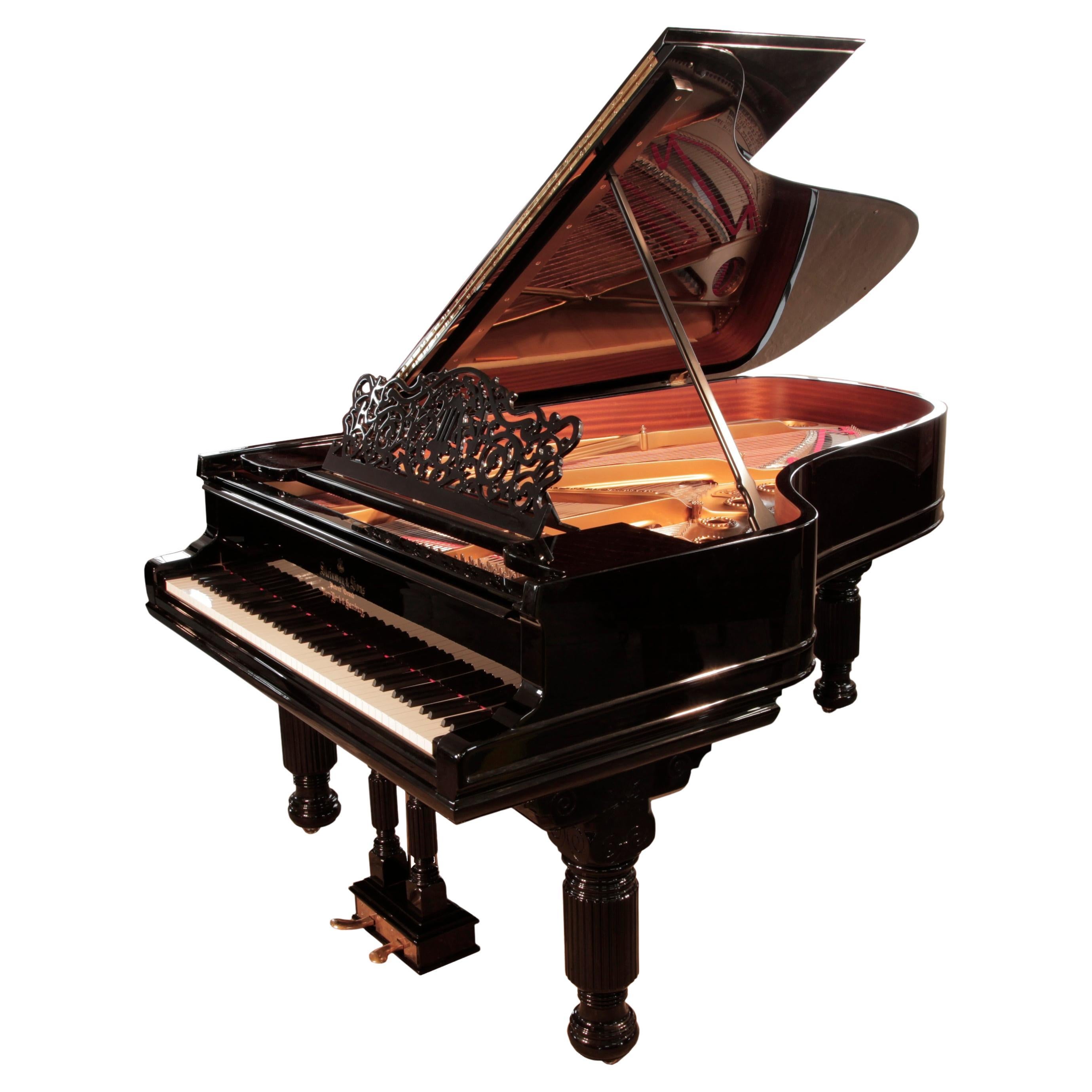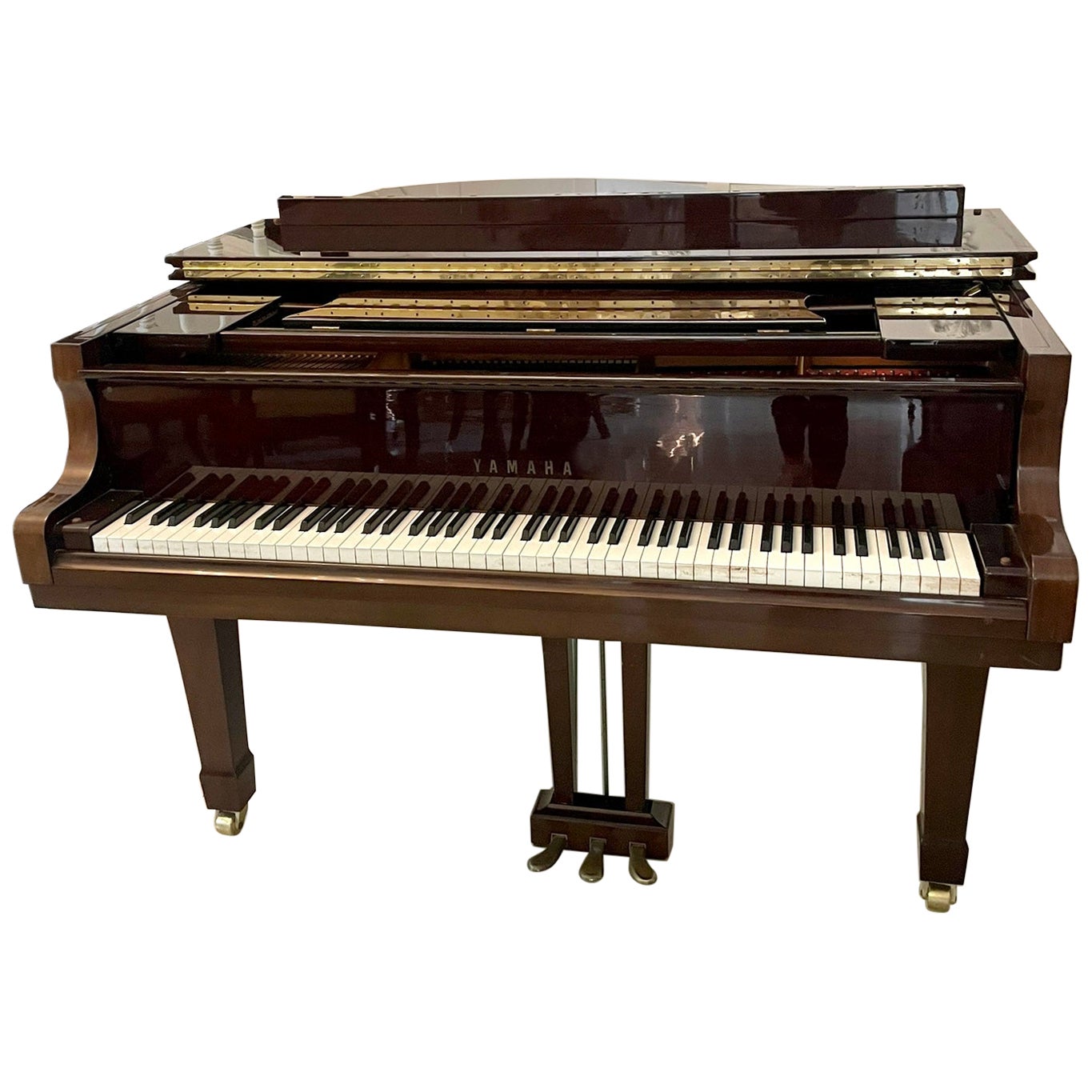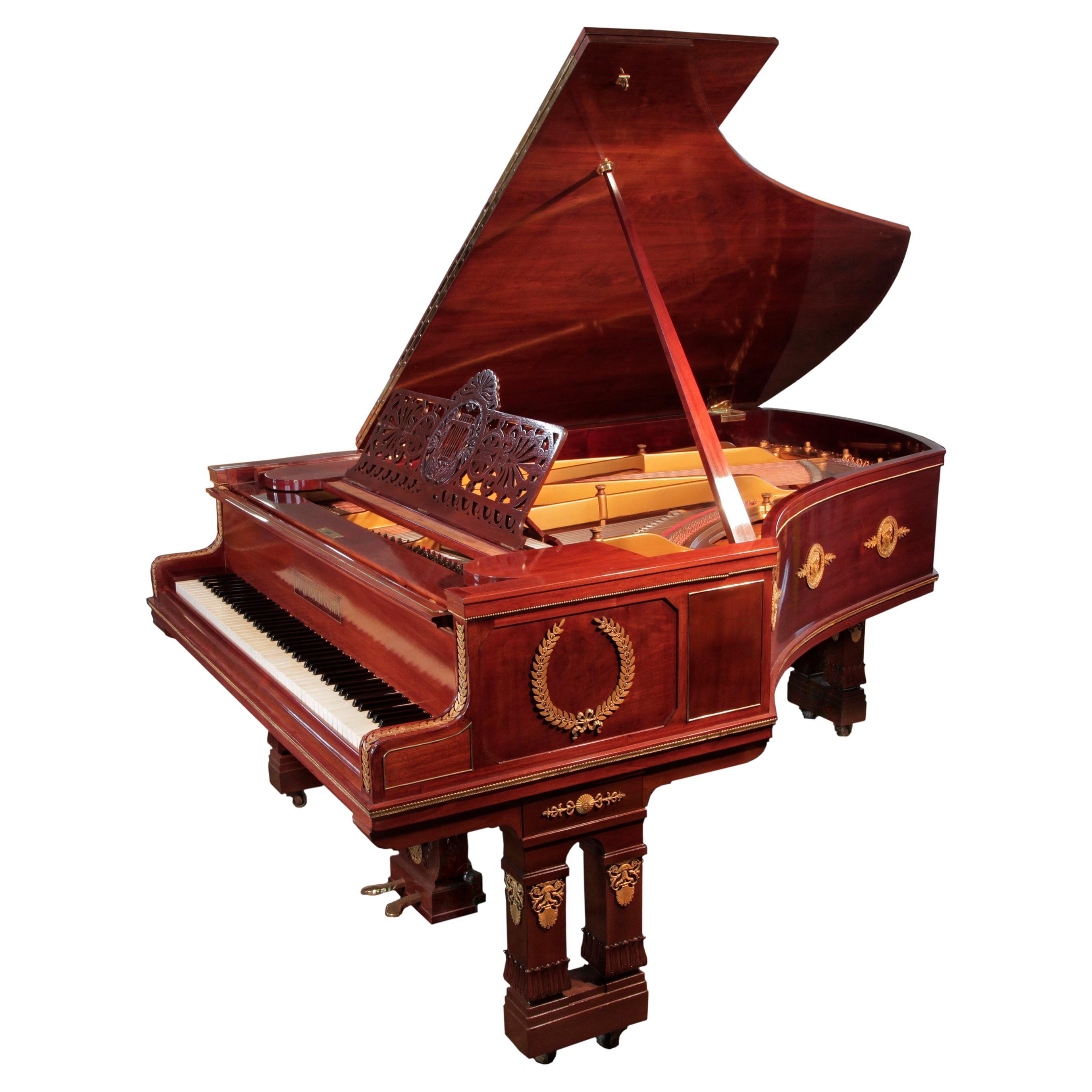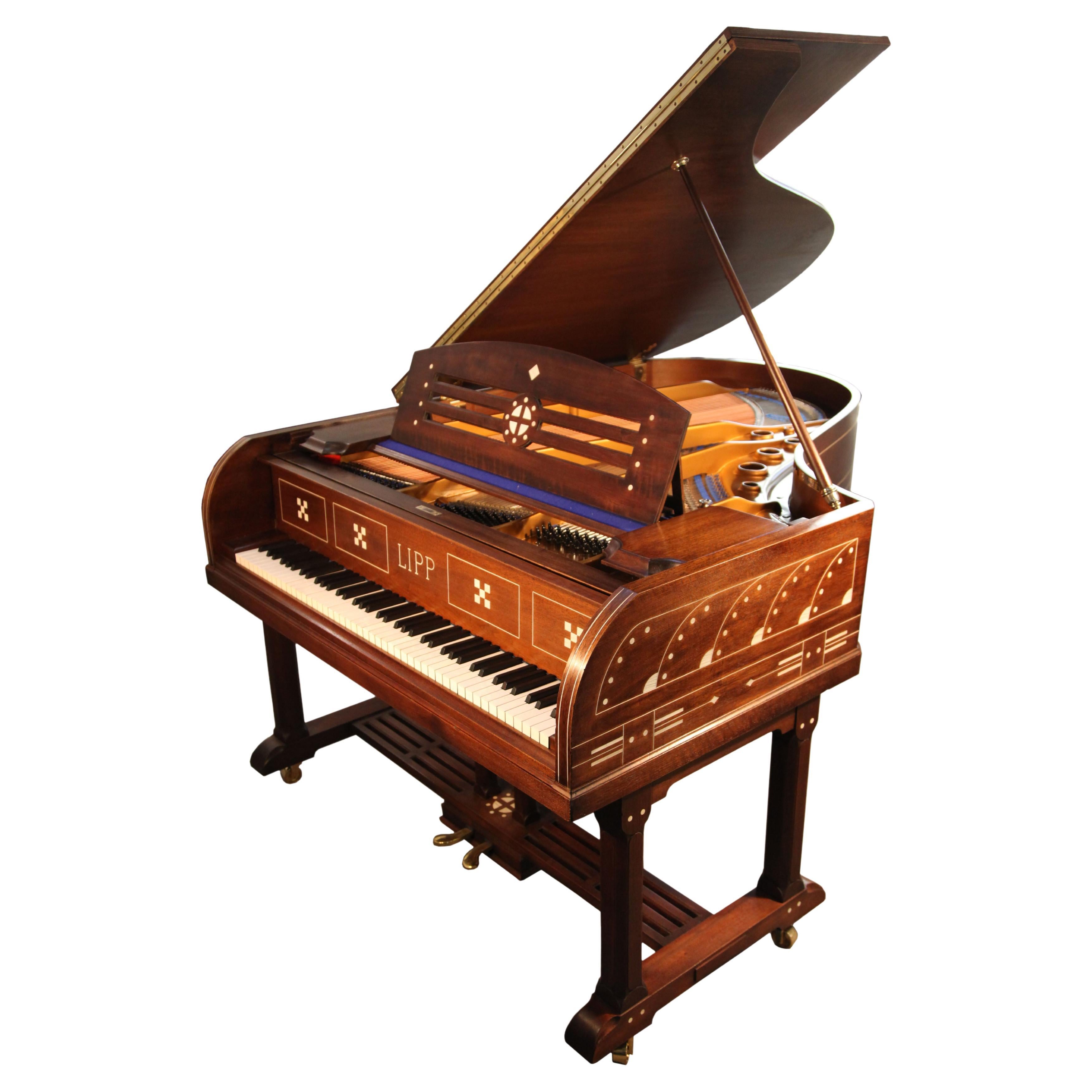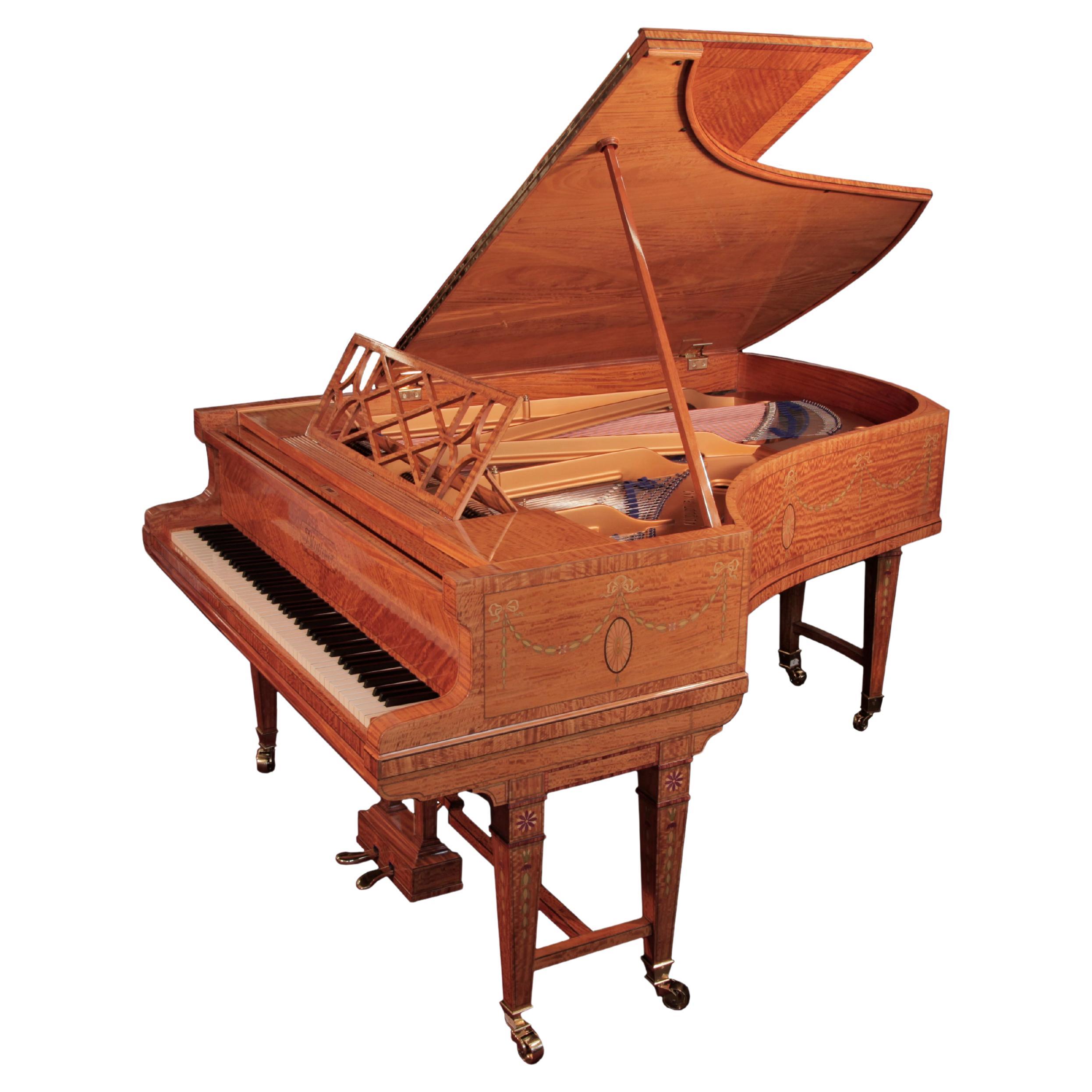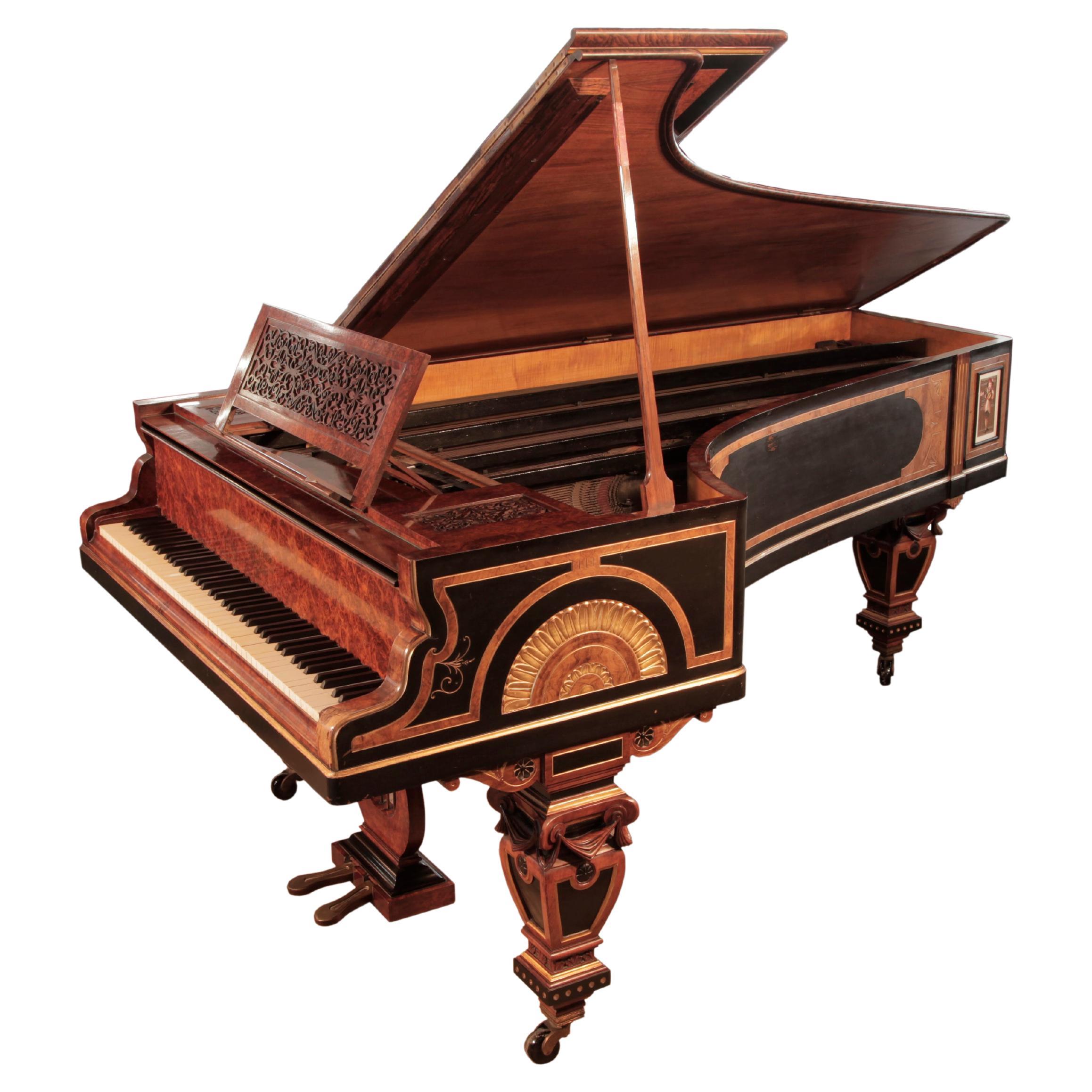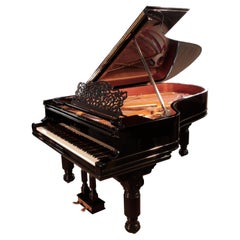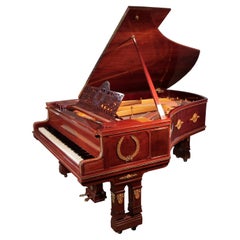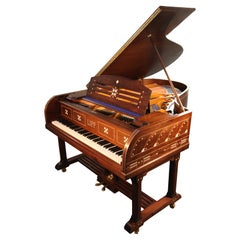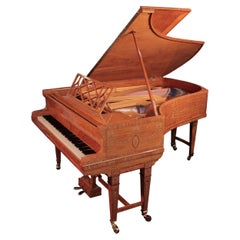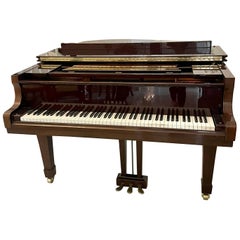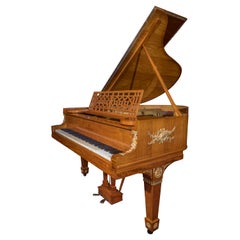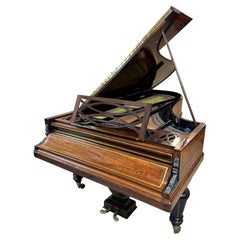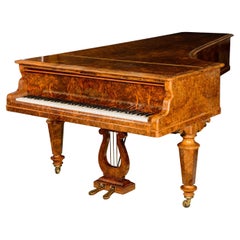Items Similar to Arts and Crafts Ibach Grand Piano Mahogany Designed by Dutch Architect Cuypers
Want more images or videos?
Request additional images or videos from the seller
1 of 16
Arts and Crafts Ibach Grand Piano Mahogany Designed by Dutch Architect Cuypers
$60,367.85
£43,750
€51,615.36
CA$83,733.34
A$91,287.66
CHF 48,234.64
MX$1,122,623.38
NOK 599,758.86
SEK 564,593.50
DKK 385,318.01
About the Item
A 1916, German Arts and Crafts, Ibach grand piano with a mahogany case and carved panel detail. The mahogany cabinet is polished so as to emphasize the quality of the wood used. The minimal rectangular lyre has two rectangular uprights separated by three circular rods. The rectangular style is continued on the gate legs with an extra embellishment of carved, stylised foliage at the leg top. The square, piano cheeks feature square cut-out indents. A strip of carved stylised flower detail runs parallel. The open work music desk features twisted brass spindles and small blocks of carved, stylised foliage. The lid stay features a statement, oversized brass hinge.
One of four ever made
This Ibach piano serial number 49571 is one of four ever made. It was designed by a Dutch architect, Pierre Joseph Hubert Cuypers. Cuypers is chiefly noted as the architect famous for designing the Rijksmuseum and Central Station in Amsterdam.
Arts and Crafts
The Arts and Crafts Movement was an international design movement that flourished between 1880 and 1910. The movement stood for traditional craftsmanship using simple forms and often applied medieval, romantic or folk motifs in decoration. It sought to reassert the importance of design and craftsmanship in the face of increasing industrialization, which was felt to sacrifice quality in the pursuit of quantity. Arts and Crafts objects were simple in form, without excessive decoration, and how they were constructed was often still visible. They tended to emphasize the qualities of the materials used. The movement was successful in raising the status of the craftsman and promoting respect for native materials and traditions.
- Dimensions:Height: 38.98 in (99 cm)Width: 61.03 in (155 cm)Depth: 79.53 in (202 cm)
- Style:Arts and Crafts (Of the Period)
- Materials and Techniques:
- Place of Origin:
- Period:
- Date of Manufacture:1916
- Condition:Wear consistent with age and use. Piano in good original condition.
- Seller Location:Leeds, GB
- Reference Number:Seller: Ref 12791stDibs: LU6879230508872
About the Seller
No Reviews Yet
Vetted Professional Seller
Every seller passes strict standards for authenticity and reliability
Established in 1979
1stDibs seller since 2022
5 sales on 1stDibs
- ShippingRetrieving quote...Shipping from: Leeds, United Kingdom
- Return Policy
Authenticity Guarantee
In the unlikely event there’s an issue with an item’s authenticity, contact us within 1 year for a full refund. DetailsMoney-Back Guarantee
If your item is not as described, is damaged in transit, or does not arrive, contact us within 7 days for a full refund. Details24-Hour Cancellation
You have a 24-hour grace period in which to reconsider your purchase, with no questions asked.Vetted Professional Sellers
Our world-class sellers must adhere to strict standards for service and quality, maintaining the integrity of our listings.Price-Match Guarantee
If you find that a seller listed the same item for a lower price elsewhere, we’ll match it.Trusted Global Delivery
Our best-in-class carrier network provides specialized shipping options worldwide, including custom delivery.More From This Seller
View AllRebuilt Steinway Model B Grand Piano Arabesque Music Desk Fluted Barrel Legs
Located in Leeds, GB
Rebuilt, 1886, Steinway Model B grand piano with a black case.
The music desk is in an openwork arabesque design featuring a central lyre motif
surrounded by stylised tendrils and foliage. The serpentine piano cheek features a dual linear case moulding. The piano lyre has two fluted spindle upright supports with two brass pedals and a brass footplate. The fluted, barrel piano legs have sunken brass casters. The leg pediment is carved with a stylised flower and curlicues. Piano has an eighty-five note keyboard.
Enjoy the vintage styling of an antique Steinway...
Category
Antique Late 19th Century German Musical Instruments
Materials
Brass
Empire Style Ibach Model 2 Grand Piano Mahogany Case Ormolu Mounts
Located in Leeds, GB
Empire style, 1901, Ibach model 2 grand piano with a mahogany case and gate legs. Entire cabinet decorated with ormolu mounts depicting classical scenes of gods, goddesses and wreaths. This piano is one of 12 unique instruments made as exhibition models...
Category
Early 20th Century German Empire Musical Instruments
Materials
Mahogany
Arts and Crafts Style Lipp Grand Piano Inlaid Germanic Folklore Motifs
Located in Leeds, GB
Arts and Crafts style, Lipp grand piano for sale with a mahogany case inlaid with symbols and designs from Germanic folklore. Case features ornate brass hinges and slatted cross stretcher. The mahogany cabinet is polished in matt to emphasize the quality of the wood used. Cabinet features a simple geometric cross stretcher supporting the simple gate legs. The Arts and Crafts period championed the simplicity of form and the construction of the object. Here, the brass hinges are accentuated with two-tone brass and stamped geometric designs. Richard Lipp...
Category
Early 20th Century German Arts and Crafts Musical Instruments
Materials
Mahogany
Adams Style Bluthner Grand Piano Quarter Cut Satinwood Inlaid Swags and Bows
Located in Leeds, GB
Adams style, 1911, Bluthner grand piano with a french polished, quarter cut, satinwood case with boxwood stringing inlay and crossbanding accents. The satinwood veneer of the cabinet...
Category
Early 20th Century German Adam Style Musical Instruments
Materials
Brass
Erard Grand Piano Egyptian Revival Neoclassical Style by William Lomax Walnut
Located in Leeds, GB
An 1861, Erard grand piano with an ornate burr walnut, black and gilt cabinet. Piano casework features Egyptian Revival and Neoclassical elements. Th...
Category
Antique Mid-19th Century English Neoclassical Musical Instruments
Materials
Porcelain, Walnut, Giltwood
Art Deco Strohmenger Baby Grand Piano Figured Walnut Square Legs and Lyre
Located in Leeds, GB
Art Deco style, 1945, Strohmenger baby grand piano with a polished, book-matched, figured walnut case and brass fittings. The high arched piano cheek ends with an angular square cut....
Category
Mid-20th Century English Art Deco Musical Instruments
Materials
Brass
You May Also Like
Yamaha Baby Grand Quality Mahogany Piano Model C2
Located in Suffolk, GB
Quality Yamaha baby grand piano with an overstrung iron frame, frame and sound board in perfect condition, mahogany case standing on square tapering legs wi...
Category
Late 20th Century English Musical Instruments
Materials
Other
Antique Steinway & Sons Gold Bronze & Satinwood Baby Piano Circa 1910
Located in New Orleans, LA
This piano was made in the Hamburg Steinway & Sons factory and decorated in France. It is a beautiful instrument. As with most pianos, special shipping will be needed.
Category
Early 20th Century German Musical Instruments
Materials
Ormolu
Pleyel Grand Piano, Paris 1870
By Pleyel
Located in Littleton, CO
This Pleyel concert grand piano crafted in Paris in 1870 is a timeless masterpiece that embodies the elegance and craftsmanship of 19th-century French piano manufacturing. Pleyel instruments are renowned for their exceptional quality and rich musicality, representing the pinnacle of piano design in the Romantic era, and this piano – an early example of the technological innovation of cross-stringing that was burgeoning during the period – is one in a series of only six ever produced.
This piano is in extraordinarily immaculate condition with nearly every original part, including the soundboard, pristine ivory keys, and the brass inlay in its beautifully figured walnut cabinet. Candle stands slide forward on either side of the collapsable music desk.
This piano was first purchased by the French Count Charles Étienne Gustave Le Clerc, count of Juigné (1825-1900), one of the wealthiest landowners in Brittany and a member of the French National Assembly, later a member of the House of Representatives, and in late life, the Senate.
The piano was restored in 1997 at Maison Erard by master restorationist Frits Janmaat in Amsterdam, and later conditioned by Edwin Beunk.
In recent years, some of Europe's finest historically-informed musical artists played this Pleyel in PBS concert performances in collaboration with the late Sergiu Luca.
Standing on substantial carved legs and brass wheels, the piano exudes a majestic presence through the graceful lines of its Second Empire style cabinet that embodies the period's aesthetics.
The keyboard, meticulously crafted from ivory and ebony, is a testament to the attention to detail in every aspect. Its 85 keys...
Category
Antique 17th Century French Romantic Musical Instruments
Materials
Walnut
$125,000
Grand piano. Walnut, metal, etc. Patent Erard London. London, England, possibly
Located in Madrid, ES
Grand piano. Walnut, metal, etc. Patent Erard London. London, England, possibly around 1870.
Requires tuning and minor restorations.
Grand or horizontal piano with strings and sou...
Category
Antique 19th Century European Other Musical Instruments
Materials
Other
Pierre-Paul Montagnac Modernist Piano
By Pierre-Paul Montagnac
Located in Philadelphia, PA
French Modernist Art Deco piano and bench by Pierre-Paul Montagnac, a variant of the model used in one of the luxe apartments, the Caen, on the great French oceanliner Normandie in 1935. Created in rosewood and sycamore, and carefully and correctly restored, including the fine Erard (#127208) instrument. 56” wide x 60” deep. Documented in numerous sources, including the July 1935 issue of Art et Decoration.
Pierre-Paul Montagnac
(1883-1961)
Born in Saint-Denis, France on 9 May 1883, Pierre-Paul Montagnac was equally talented as a fine artist and a decorative artist. He was educated in both disciplines, studying with Eugene Carriére as well as at the Académie de la Grande Chaumiére, both in Paris.
His inaugural exhibition was at the 1912 Salons – and at the 1920 Salon d’Automne he received a traveling scholarship. In 1918 he began working in the firm of André Mare and from 1922 collaborated with Maurice Dufrene at La Maîtrise, the famous design studio of Galeries Lafayette. From 1921 he exhibited at the Salons of la Société des Artistes Décorateurs, Salon des Architectes Modernes,
and internationally, in Barcelona and Leipzig. He designed suites on the grand French oceanliners, l’Atlantique, Normandie and Pasteur.
At the 1925 Paris International Exposition his work was in a standout class. At the 1937 Exhibition he organized the pavillion of the Artistes Decorateurs and personally won a Grand Prix. For the New York Exhibition in 1938, he was a member of the international jury, organized the group of Decorators, and, as architect, organized the exhibitions of jewelry and perfumes.
He became a member of the Society of Modern Architects and executed important and numerous architecture and decorating projects including the luxury apartments on the great French oceanliners l’Atlantique, Pasteur, and Normandie.
Vice President and then President of the Societe des Artistes Decorateurs from 1930-1938, he was also President of the Salon d’Automne and Vice President of the Committee of the Exhibition of Arts and Embellishments of Life; member of the steering committee of C.T.I. and Artistic Property, member of the Board of Directors of the Central Union of Decorative Arts. He was also an Officer of the Legion of Honor and received the Cross of War.
MONTAGNAC was the son of an engineer and he had a taste for geometry
and science that predisposed him to the rigors of architectural laws.
Multi-talented, he worked independently as a painter – who had
paintings acquired by the French government – while also working in
the related fields of architecture and decoration. His work included
homes, apartments, galleries, luxury shops, banks and the aforesaid
oceanliners.
As a designer/decorater, Montagnac had the taste for quality, luxurious
furniture, using precious woods, bronze extensions, ivory inlays, mother-of-pearl,
metal and coral. He advocated for a resolutely modern style and, free of all
pastiches, focused on beautiful cabinetry, the challenges of furniture design,
particularly from 1940 to 1945, captured all his attention.
The tireless activity of Montagnac, whose varied works are represented in
official museums and residences, was also recognized from a professional
and social point of view. He was a remarkable organizer, devoted to the
cause of art, to the defense of the trade and his colleagues. It was Montagnac
who, in 1939, with Anatole de Monzie, took the initiative to found the
ENTRAIDE to Artists (which provides support to talented young French artists).
MOBILIER ET DECORATION, September/October 1953
ERARD
An illustrious piano manufacturer, Sebastien Erard began building superior harpsichords in Paris in the mid-1700s, produced pianos for the French Court, and received a multitude of patents, many of which are still in use in piano manufacturing. Erard pianos were marketed as the finest pianos in the world and were owned by Queen Victoria, Franz Liszt, Chopin, Verdi, Ravel, and Felix Mendelssohn among many others. They continued to enjoy international success well into the 20th century. They were known for their unique sound quality, similar to the American square grand piano...
Category
Vintage 1930s French Art Deco Musical Instruments
Materials
Rosewood, Sycamore
Erard Parallel-Strung Grand Piano, Paris, 1845
By Sébastien Érard
Located in Littleton, CO
This Erard parallel-strung grand piano, crafted in Paris in 1845 (serial number: 18725), has been extraordinarily well-tended, restored and maintained, enduring today as not only a spectacular example of the pinnacle of 19th Century piano design - characterized by its innovative construction and exceptional sonoral qualities - but also as a premium instrument by the most advanced modern standards, concert-ready for world-class, discriminating performers and their audiences.
Erard was a renowned piano manufacturer established by Sébastien Erard, and for much of the 19th Century, the company produced some of the most exquisite and innovative European pianos of the era.
The sound produced by this parallel-strung grand piano is characterized by a clarity and transparency that distinguishes it from its contemporaries. The parallel arrangement of strings contributes to a more direct transfer of sound energy, resulting in a balanced and articulate tone across the instrument's registers.
This piano's tone is beloved for its sweetness in the treble range and a robust quality in the bass, while also allowing for an especially nuanced and expressive interpretation of the musical repertoire of its era.
The ebony and ivory keyboard is a testament to the meticulous attention Erard paid to the tactile experience of playing. Each key is precision-weighted, providing a responsive touch that allows the pianist to articulate a wide range of dynamics and expressiveness.
An interior faux tableau latches to the outer case lid in an open position for maximum concert volume, and rests in a lowered position to maintain a softer, more muted experience.
The year 1845 places this Erard instrument in the heart of the Romantic era, a period marked by a surge in musical creativity and emotional expression. Composer/performers like Chopin and Liszt were drawn to Erard grand...
Category
Antique Mid-19th Century French Romantic Musical Instruments
Materials
Wood
More Ways To Browse
Mahogany Piano
Square Piano
Antique Square Pianos
Vintage Instrument Cases
Baby Grand Piano
Vintage Record Player Radio
Vintage Record Players
Vintage Wood Radio
Ph Pianos
Poul Henningsen Piano
Record Bar
Swiss Music Boxes
Brass Music Box
Tube Radios
Bakelite Vintage Radio
Radio 1970
Wood Record Player
Antique Cylinder Music Boxes
